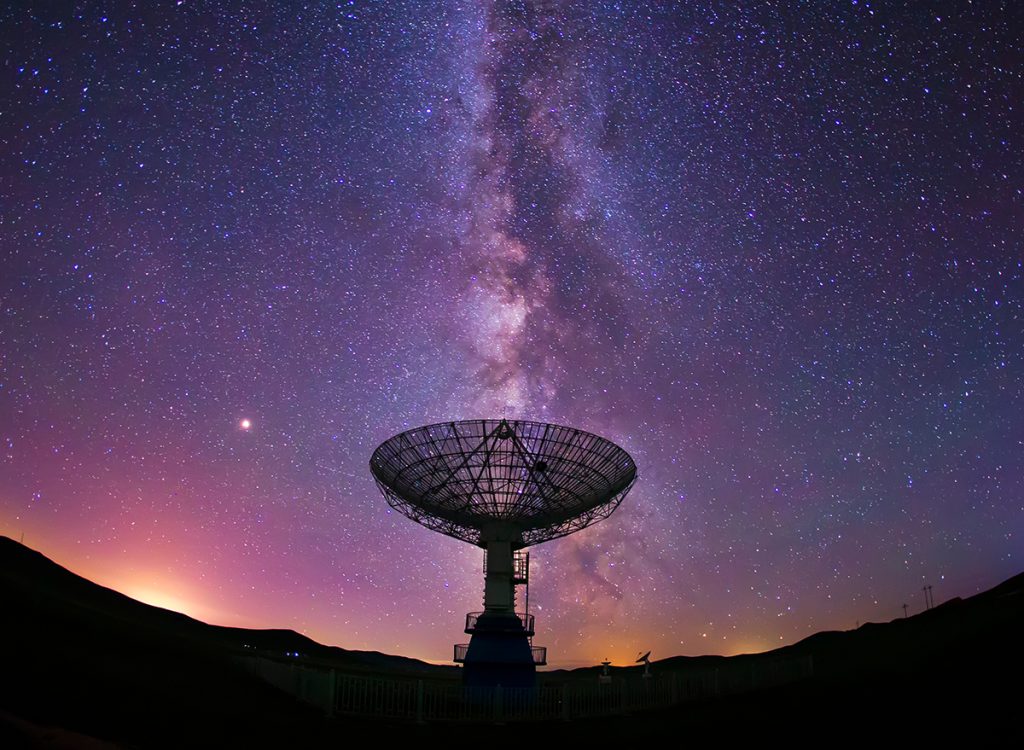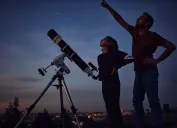You Can See 400,000 "Strikingly Beautiful" Galaxies in This New Map of Space
The Siena Galaxy Atlas is an unprecedented free way to take an in-depth look at the universe.

Any amateur astronomer will tell you that there's something special about sitting outside with your telescope and taking in the distant wonders of the night sky. But with a bit of help from professional scientists using cutting-edge technology, it's possible to get an even better view of far-off star systems swirling with their own mesmerizing, colorful displays. And now, researchers have announced the release of the Siena Galaxy Atlas, which allows you to see almost 400,000 "strikingly beautiful" galaxies with a few simple clicks. Read on to see how the offering came to be and what it could mean for future studies of the cosmos.
RELATED: The Next Total Solar Eclipse Will Be the Last Until 2044, NASA Says.
A new space atlas provides access to images of 400,000 galaxies.

Stunning images of the universe can be especially captivating with their vivid, swirling colors that stoke our imaginations and curiosity. Typically, these pictures find their way to us when a new series has been released before they eventually become the backgrounds on our phone screens.
But now, scientists at the National Optical-Infrared Astronomy Research Laboratory (NOIRLab) have announced the release of the Siena Galaxy Atlas (SGA), a collection of images of nearly 400,000 galaxies from across the universe that's free for the public to access, according to a press release.
The massive library is a compilation of images taken by the Dark Energy Spectroscopic Instrument (DESI) Legacy Surveys between 2014 and 2017, which were used to identify possible galaxies as targets for future research for the project. Scientists used state-of-the-art telescopes at Cerro Tololo Inter-American Observatory (CTIO) in Chile and Kitt Peak National Observatory (KPNO) at the University of Arizona's Steward Observatory to collect the data, per the press release.
RELATED: 6 Stargazing Secrets, According to Astronomy Experts.
The data will help scientists focus more efficiently on studying the universe.

The release of the data and image library marks a significant advancement in studying the cosmos. While scientists have long used research databases to help identify patterns and target potentially important areas of study, datasets typically had to be regularly updated as new technology became available. But the SGA's release marks the first time a mother lode of such information has been made available all at once using cutting-edge instruments.
The project's scope is also monumental, scanning a total area of 20,000 square degrees that covers half the night sky, according to the NOIRLab press release. It marks the first time highly accurate information on the location, shape, and size of so many galaxies has been made available.
"Nearby large galaxies are important because we can study them in more detail than any other galaxies in the universe; they are our cosmic neighbors," John Moustakas, PhD, SGA project leader and a physics professor at Siena College, said in the NOIRLab press release. "Not only are they strikingly beautiful, but they also hold the key to understanding how galaxies form and evolve, including our very own Milky Way galaxy."
RELATED: Intense Solar Storms May Peak Faster Than Expected—What That Means for Earth.
The latest findings improve upon previous research.

Even though the SGA represents the most up-to-date information available, it's far from the first attempt to coherently map the cosmos. The research team cites projects dating back centuries, including the Catalogue des Nébuleuses et des Amas d'Étoiles (Catalogue of Nebulae and Star Clusters) first released in 1774 by astronomer Charles Messier, the New General Catalogue of Nebulae and Clusters of Stars (NGC) published in 1888 by John Louis Emil Dreyer, and the Third Reference Catalogue of Bright Galaxies in 1991. However, they also cite other recent atlases that are missing a significant number of galaxies and rely on outdated measurements.
"Previous galaxy compilations have been plagued by incorrect positions, sizes, and shapes of galaxies, and also contained entries which were not galaxies but stars or artifacts," Arjun Dey, PhD, a project scientist and astronomer at the NOIRLab, said in the statement. "The SGA cleans all this up for a large part of the sky. It also provides the best brightness measurements for galaxies, something we have not reliably had before for a sample of this size."
RELATED: Meteors With "Glowing Trains" Will Light Up the Sky This Weekend—How to See Them.
Scientists are also excited about how the public could use the new galaxy atlas.

Researchers are confident that the SGA will help foster new research on everything from why different galaxies appear the way they do to how lesser-known things like dark matter are spread out around the universe, per the NOIRLab press release. But they're also quick to note that citizen scientists and amateur astronomers will also be able to put the treasure trove of information to use.
"The public release of these spectacular data contained in the atlas will have a real impact not only on astronomical research, but also on the public's ability to view and identify relatively nearby galaxies," Chris Davis, NSF Program Director for NOIRLab, said in the statement. "Dedicated amateur astronomers will particularly love this as a go-to resource for learning more about some of the celestial targets they observe."
Others agree that the free resource could also be a gratifying way to explore the cosmos even from their desks. "The SGA is going to be the pre-eminent digital galaxy atlas for large galaxies," Dey said in the press release. "In addition to its scientific utility, it has a lot of pictures of beautiful galaxies!"
RELATED: For more up-to-date information, sign up for our daily newsletter.





















